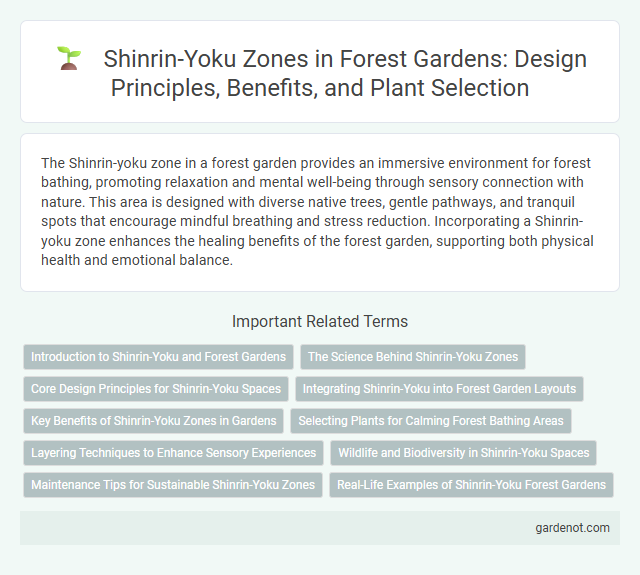The Shinrin-yoku zone in a forest garden provides an immersive environment for forest bathing, promoting relaxation and mental well-being through sensory connection with nature. This area is designed with diverse native trees, gentle pathways, and tranquil spots that encourage mindful breathing and stress reduction. Incorporating a Shinrin-yoku zone enhances the healing benefits of the forest garden, supporting both physical health and emotional balance.
Introduction to Shinrin-Yoku and Forest Gardens
Shinrin-yoku, or forest bathing, immerses visitors in a therapeutic environment designed to enhance mental and physical well-being through mindful interaction with nature. Forest gardens integrate diverse plant species in layered arrangements, creating a dynamic ecosystem that supports biodiversity and promotes relaxation. This harmonious blend of Shinrin-yoku principles and forest garden design fosters restorative experiences by engaging all senses in natural surroundings.
The Science Behind Shinrin-Yoku Zones
Shinrin-yoku zones leverage biophilic design principles to enhance human interaction with natural forest environments, promoting mental restoration and reducing stress through phytoncide exposure emitted by trees. Scientific studies reveal that spending time in these zones significantly boosts immune function by increasing natural killer cell activity and decreasing cortisol levels. The integration of diverse native plant species amplifies biodiversity, supporting ecosystem health and elevating overall wellbeing benefits for visitors.
Core Design Principles for Shinrin-Yoku Spaces
Core design principles for Shinrin-yoku zones emphasize natural immersion through dense, biodiverse vegetation that stimulates the senses and promotes mental restoration. Incorporating layered plant strata, winding paths, and water features enhances the therapeutic environment by encouraging mindfulness and reducing stress. Spatial organization prioritizes safety and tranquility, ensuring visitors can deeply connect with nature without distractions.
Integrating Shinrin-Yoku into Forest Garden Layouts
Integrating Shinrin-yoku into forest garden layouts enhances mental well-being by creating immersive, multisensory environments that promote relaxation and stress reduction. Design elements such as winding paths, diverse native tree species, and quiet seating areas optimize the therapeutic benefits of forest bathing. Strategic placement of flora encourages mindfulness and deep connection with nature, making the forest garden a revitalizing sanctuary.
Key Benefits of Shinrin-Yoku Zones in Gardens
Shinrin-yoku zones in gardens provide immersive forest bathing experiences that reduce stress and enhance mental well-being by promoting mindfulness and relaxation. These zones improve air quality through abundant tree canopies, contributing to better respiratory health. Exposure to natural phytoncides in these spaces strengthens the immune system and boosts overall vitality.
Selecting Plants for Calming Forest Bathing Areas
Selecting plants for Shinrin-yoku zones emphasizes native species known for their calming scents and textures, such as Japanese cedar (Cryptomeria japonica) and hinoki cypress (Chamaecyparis obtusa). Incorporating evergreen plants and mosses enhances year-round tranquility and grounding sensations, promoting stress reduction during forest bathing. The inclusion of aromatic herbs like sweet woodruff (Galium odoratum) further elevates the sensory experience by releasing subtle, soothing fragrances.
Layering Techniques to Enhance Sensory Experiences
Shinrin-yoku zones use strategic layering techniques to amplify sensory engagement, incorporating diverse plant strata such as towering canopy trees, mid-level shrubs, and ground-cover flora that stimulate sight, smell, and touch. Multi-sensory layering includes textured bark, aromatic foliage, and varied leaf colors to enrich immersion and promote mindfulness in forest garden settings. These design approaches cultivate a harmonious environment, encouraging deep connection with nature and enhancing the therapeutic benefits of forest bathing.
Wildlife and Biodiversity in Shinrin-Yoku Spaces
Shinrin-yoku zones foster rich wildlife habitats by preserving native plant species and creating layered forest structures that support diverse animal populations. These areas enhance biodiversity through natural regeneration processes, providing food sources and nesting sites for birds, insects, and mammals. Maintaining ecological balance in Shinrin-yoku spaces promotes resilience against environmental stresses and sustains ecosystem services.
Maintenance Tips for Sustainable Shinrin-Yoku Zones
Regular pruning of native plants and removal of invasive species maintain the ecological balance in Shinrin-yoku zones, promoting biodiversity and enhancing visitor experience. Implementing seasonal soil mulching and organic composting improves soil health, supporting long-term forest resilience. Monitoring foot traffic paths and installing boardwalks prevent soil compaction, ensuring sustainable access to the natural environment.
Real-Life Examples of Shinrin-Yoku Forest Gardens
Shinrin-yoku forest gardens like the Akasawa Natural Recreation Forest in Japan demonstrate measurable health benefits, including reduced cortisol levels and improved mood among visitors. The Forest Therapy Center in Oregon integrates diverse native plants to enhance sensory experiences, promoting stress relief through guided forest immersion. These real-life examples highlight how carefully designed forest gardens embody the practice of Shinrin-yoku, fostering mental well-being and ecological harmony.
Shinrin-yoku zone Infographic

 gardenot.com
gardenot.com